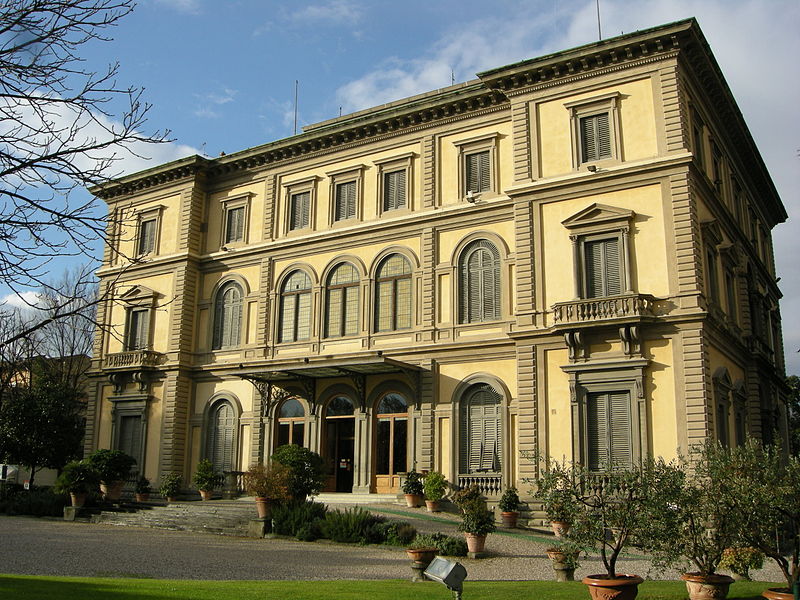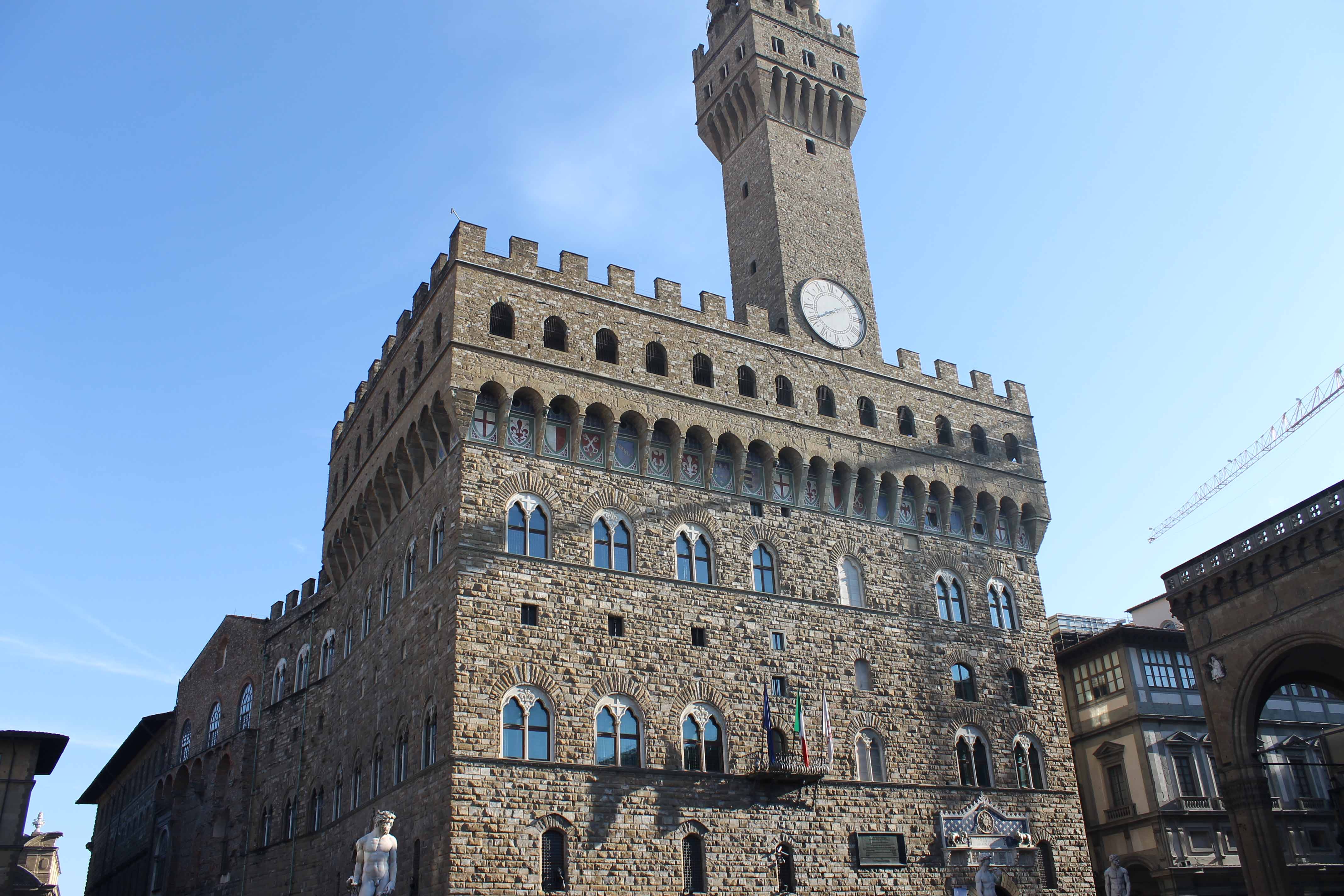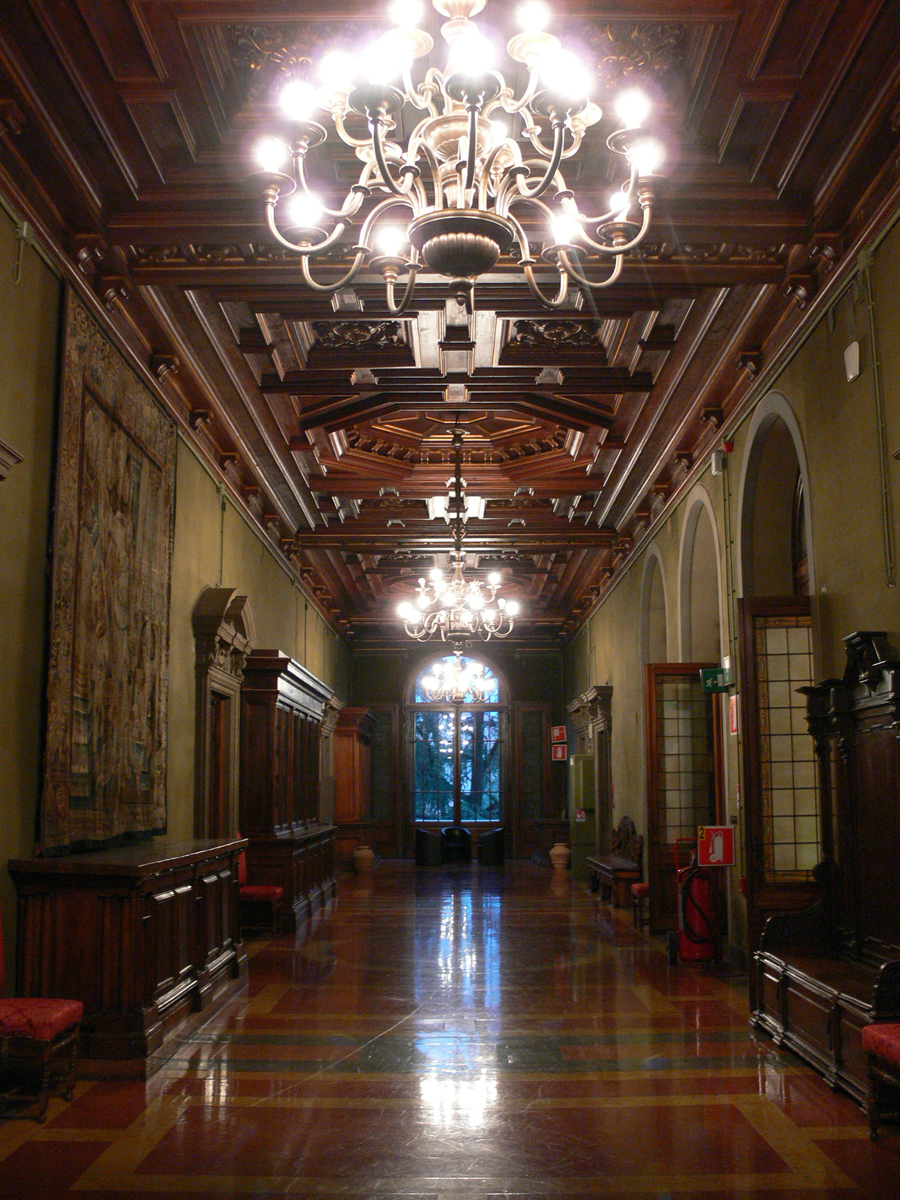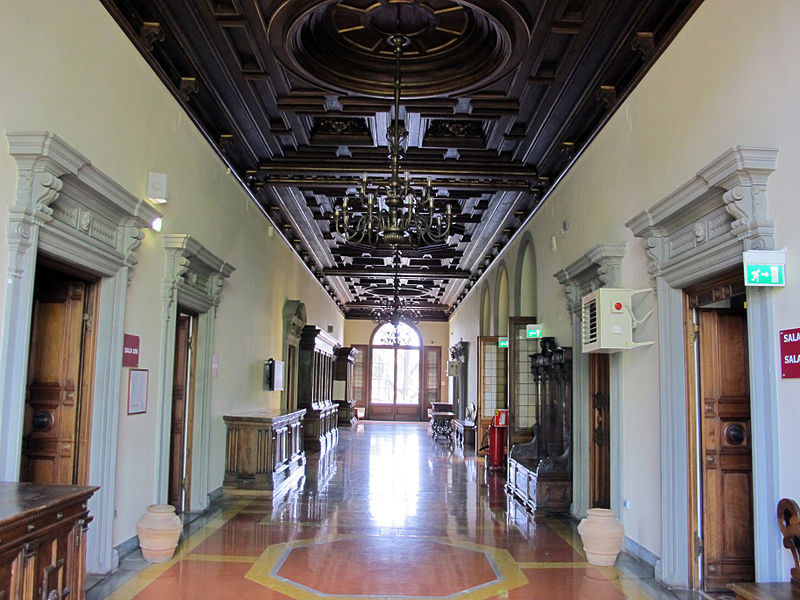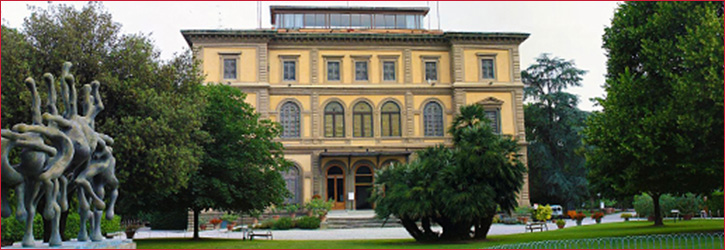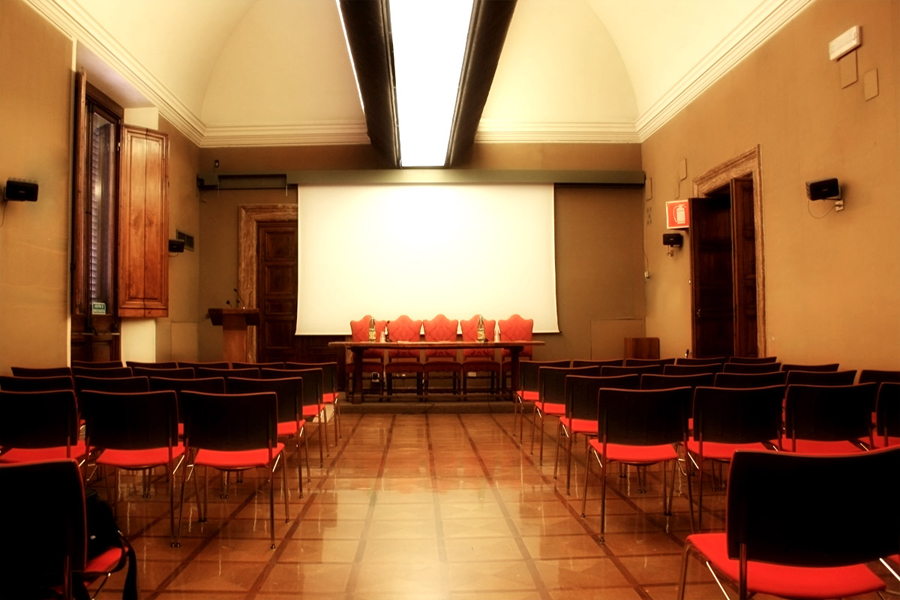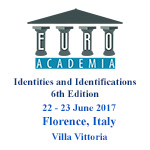Villa Vittoria – Palazzo dei Congressi
Conference Room: Onice 1 Piazza Adua – 50123 Florence, ItalyConference Program
- June 22, 2017
- 09:00 - 09:30Registration (Registration Desk – Villa Vittoria)
- 09:30 - 10:30Welcome and Opening Remarks / Opening Workshop: Researching Identities Today
- 10:30 - 11:00Coffee Break
- 11:00 - 13:00Panel 1: Theorizing Identity and the Self(Section One): Personhood, Recognition, Trust and Ambivalence
- 13:00 - 14:30Tuscan Specialties Lunch – Restaurant
- 14:30 - 16:30Panel 2: Narrative Identities: Intellectual History Readings of Discursive Identity Making Practices from Fiction to Personal Archives
- 16:30 - 17:00Coffee Break
- 17:00 - 19:00Panel 3: (En)Gendering Identities: Gender Narratives and Identities as Social Constructs
- 19:00 - 19:15Book Presentation: Ambivalence: A Philosophical Exploration, by Hili Razinsky
- 19:15 - 19:45Welcome ‘Aperitivo’ Drink Out in Florence
- 19:45 - 21:00Optional Tuscan Dinner in Florence
- June 23, 2017
- 08:30 - 10:30Panel 4: Theorizing Identity and the Self (Section 2): Makings of the Self from Constitution, Structuring, Moral Evaluation and Affectivity to Collective Identitarian Claims
- 10:30 - 11:00Coffee Break
- 11:00 - 13:00Panel 5: Art, History and Identity Making: Visual Narratives of Identity
- 13:00 - 14:30Tuscan Specialties Lunch - Restaurant
- 14:30 - 16:30Panel 6: Identity and the ‘Visual Turn’ in Social Representations: From Performing Arts and Visual Discourses to Urban Image Construction and Change
- 16:30 - 17:00Coffee Break
- 17:00 - 19:00Panel 7: Identities as Endogenous Factors in Explaining Socio- Political Behaviors: Historical and Political Readings of Social Identitarian Claims
- 19:00 - 19:30Concluding Remarks and Discussions
- 19:30 - 21:00Optional Social Dinner in Florence
- June 22, 2017
Identities and Identifications: Politicized Uses of Collective Identities (6th Edition)

- Conference Description
- Participant’s Profile
- Registration and Fee
- Social Activities and Publication
- Important Dates
- Venue and Directions
- Conference Program
- Panel 1
- Panel 2
- Panel 3
- Panel 4
- Panel 5
- Panel 6
- Panel 7
- Book Presentation
The 6th Euroacademia International Conference
Identities and Identifications
Politicized Uses of Collective Identities
22 – 23 June 2017
Villa Vittoria – Palazzo dei Congressi
Florence, Italy
Conference Description
Identity is one of the crown jewelries in the kingdom of ‘contested concepts’. Few concepts are so integral to social assumptions, beliefs and claims of belonging while simultaneously escaping a clear definition or even a minimal consensus. The idea of identity is conceived to provide some unity and recognition while it also exists by separation and differentiation. From personal to group and collective identities, multiple layers of identifications juxtapose conflict or exclude. Few concepts were used as much as identity for contradictory purposes. From the fragile individual identities as self-solidifying frameworks, to layered in-group identifications in families, orders, organizations, religions, ethnic groups, regions, nation-states, supra-national entities or any other social entities, the idea of identity always shows up in the core of debates and makes everything either too dangerously simple or too complicated. Constructivist and de-constructivist strategies have led to the same result: the eternal return of the topic. Some say we should drop the concept, some say we should keep it and refine it, some say we should look at it in a dynamic fashion while some say it’s the reason for resistance to change. In the meantime, identities are programmatically asserted and promoted to generate cohesion and demand recognition while the process of identification excludes and creates boundaries and alterity making practices.
If identities are socially constructed and not genuine formations, they still hold some responsibility for inclusion/exclusion – self/other nexuses. Looking at identities in a research oriented manner provides explanatory tools for a wide variety of events and social dynamics. Identities reflect the complex nature of human societies and generate reasonable comprehension for processes that cannot be explained by tracing pure rational driven pursuit of interests. The feelings of attachment, belonging, recognition, the processes of values’ formation and norms integration, the logics of appropriateness generated in social organizations, are all factors relying on a certain type of identity or identification. Multiple identifications overlap, interact, include or exclude, conflict or enhance cooperation. Identities create boundaries and borders; define the in-group and the out-group, the similar and the excluded, the friend and the threatening, the insider and the ‘other’. Even more, identities generate legitimating circumstances for social and political action; assert the power of naming and rules of belonging while setting the stage for the perception of the other. The other can be internal, as difference and incomplete coherence with the in-group, or external as acknowledged difference or even in cases of radical alterity as perceived threat. The formation of identities can lead to multicultural integration of diversity, tolerance, recognition and pluralism while simultaneously exclude and build walls.
Beyond their dynamic fuzzy nature that escapes exhaustive explanations, identities are effective instruments for the politicization of social life. The construction of social structures and of specific social practices together with their imaginary significations, requires all the time an essentialist or non-essentialist legitimating act of belonging; a social glue that extracts its cohesive function from the identification of the in-group. Identities are political. Multicultural values populate extensively the twenty-first century, yet the distance between the ideal and the real multiculturalism persists while the virtues of inclusion coexist with the adversity of exclusion. Dealing with the identities means to integrate contestation into contestation until potentially a ‘n’ degree of contestation. Due to the confusion between identities and identifications, some scholars demanded that the concept of identity shall be abandoned. Identitarian issues turned out to be efficient tools for politicization of a ‘constraining dissensus’ while universalizing terms included in the making of the identities usually tend or intend to obscure the localized origins of any identitarian project. Identities are most often advanced as intentional concepts: they don’t say anything about their sphere but rather defining the sphere makes explicit the aim of their usage. It is not ‘identity of’ but ‘identity to’.
The Sixth Euroacademia International Conference ‘Identities and Identifications: Politicized Uses of Collective Identities’ aims to scrutinize the state of the art in collective identities research, to bring once more into debate the processes of identity making, identity building in both constructivist or de-constructivist dimensions. The conference will include a wide variety of contributions on identity making practices while fostering a critical assessment of intended or unintended consequences that lead to the politicization of identities. It is the aim of the Euroacademia conference to open the floor to dynamic multi-dimensional and inter-disciplinary understandings of identities in their historic formation or in the way they shape the present and future of organizations or communities. The conference however seeks also to integrate and address the misunderstandings or misconceptions implicit to identity formation practices. A focal place will be given to methodological refinement and innovation in the research of identities in a broad spectrum of disciplines.
Euroacademia aims to bring together a wide network of intellectuals, academics, researchers, practitioners and activists that are willing to share and open to debate their research on identity related topics. Disciplinary, trans and inter-disciplinary approaches, methodological assessments, innovations and recommendations, single case studies or cross-sectional analyses, reflective essays, experience sharing or works addressing new puzzles are all welcomed.
Participant’s Profile
The conference is addressed to academics, researchers and professionals with a particular interest related to the topic of collective identities from all parts of the world. Senior and junior researchers are equally welcomed. As the nature of the conference is intended to be multidisciplinary in nature, different academic backgrounds are welcomed.
Post-graduate students, doctoral candidates and young researchers are welcomed to submit an abstract. Representatives of INGOs, NGOs, Think Tanks and activists willing to present their work or projects with impact on or influenced by specific understandings of identities are welcomed as well to submit abstracts of their contributions.
Abstracts will be reviewed and the participants are selected based on the proven quality of the abstract. The submitted paper for the conference proceedings is expected to be in accordance with the lines provided in the submitted abstract.
Registration and Fee
The Registration Process is Closed
The Participation Fee Includes:
- the registration fee
- participant’s package with all the materials for the conference
- eligibility for publishing the presentation in the conference follow-up publications
- access to Euroacademia discussion group and newsletters
- 2 daily coffee brakes during the conference
- a welcome drink and Tuscan aperitivo on 22nd of June 2017
- a 3 course Tuscan specialties lunch on 22nd of June 2017
- a 3 course Tuscan specialties lunch on 23rd of June 2017
- certificate of attendance
- access to optional social program
Social Activities and Publication
A specific spot in the conference program will be dedicated to social networking and therefore all the participants interested in setting or developing further cooperation agendas and prospects with other participants will have time to present and/or promote their project and express calls for cooperation.
A specific setting (Social Corner) for promotional materials connected with the topic of the conference will be reserved for the use of the participants. Books authored or edited by the participants can be exhibited and promoted during the whole period of the conference and can also be presented within the conference package based on prior arrangements.
Photos and videos will be taken during the conference and the organizers will consider through the participation of selected presenters or members of the audience that the agreement for being photographed or filmed during the event was granted through registration to the event. Please notify the organizers in written form prior to the the event if you are a confirmed participant and would prefer otherwise.
An optional dinner and as social event will be organized for the first and second evening of the conference in a typical Tuscan cuisine restaurant as optional program for the willing participants. The social dinner will be held based on participant’s prior confirmation and it will be covered by the participants individually at the restaurant.
Publication:
Selected papers will be eligible for publishing in thematic volumes or published in an electronic volume with ISBN after the confirmation of the authors and a double peer-review process based on an agreed publication schedule after the conference. All the papers selected for publication should be original and must have not been previously published elsewhere.
| Important Dates | |
|---|---|
| 15th of April 2017 | Deadline for Submitting Panel Proposals |
| 10th of May 2017 | Deadline for Paper Proposals: 300 words abstracts and details of affiliation |
| 11th of May 2017 | Latest notification of acceptance |
| 15th of May 2017 | Sending the Registration Form |
| 20th of May 2017 | Payment of the conference fee |
| 10th of June 2017 | Sending the draft paper to be uploaded on the web site of the conference |
| 15th of June 2017 | Publication of the conference program and uploading the draft papers on the website |
| 22nd of May 2017 | The conference commences at 9.00 am |
Venue and Directions
The conference will take place in the conference premises of the beautiful Villa Vittoria – Palazzo dei Congressi, centrally located in the historic heart of Florence, few steps away from the Santa Maria Novella church and the amazing Duomo with its Cupola del Brunelleschi and Campanile di Giotto making easily accessible within a walking distance any part of the amazing Renaissance treasure of the historic center. Galleria dell’Accademia, where the original of the astonishing masterpiece of Michelangelo – David – can be admired in all its splendor and perfection, is within a few minutes walking distance. In short walking distances can be easily reached the Piazza della Signoria and the Uffizzi Galery containing the largest collection of Renaissance art in the world.
Located inside the 18th century Villa Vittoria – Palazzo dei Congressi boasts prestigious auditoriums and is surrounded by a centuries-old garden. The charming interiors of the venue are characterized by a combination of Florentine antique furniture with modern and functionally designed halls. Villa Vittoria and its adjacent Lemon House are connected to the Fortezza da Basso through a pedestrian square, thus forming a conference area which is completely accessible on foot, in the heart of the city. It is a luxury establishment where the secret ingredients of tradition, history and modernity are blended in perfect proportions and surrounded by marvelous edifices that host the largest Renaissance art collections in the world.
Villa Vittoria – Palazzo dei Congressi
Firenze Fiera, Piazza Adua, 1,
Florence, Italy, 055 49721

A city-size shrine to the Renaissance, Florence offers frescoes, sculptures, churches, palaces, and other monuments from the richest cultural flowering the world has known. Names from its dazzling historical past—Dante, Michelangelo, Galileo, Machiavelli—are some of the most resonant of the medieval age.
But to see the Tuscan capital simply as Europe’s preeminent city of art would be to ignore not only its role as a dynamic and cosmopolitan metropolis, but also to overlook its more unsung charms—Italy’s most visited gardens (and its best ice-cream parlor), idyllic strolls on balmy summer evenings, a broad range of specialty shopping, sweeping views over majestic cityscapes, eating experiences that range from historic cafés to the country’s most highly rated restaurants, and the kind of seductive and romantic pleasures that somehow only Italy knows how to provide.
Florence is the best place to discuss and affirm culture and critical thinking as it is a beautiful place that significantly shaped the formation of modern identity of Europe through humanism, love for beauty, amazing arts and craftsmanship, respect for the past and a look into the future.
See full information about the conference Location & Map:
HERE
Conference participants are responsible for arranging the accommodation and travel to/in Florence.
Conference Program
The Conference Agenda is available in the right sidebar of this page.
The extensive conference program with abstracts and available draft papers is accessible below by clicking on the panel number tabs and individual presentations.
Theorizing Identity and the Self(Section One): Personhood, Recognition, Trust and Ambivalence
- The Right of Resistance as the Struggle for Recognition: Reading Hegel Against HegelThe present analysis examines Honneth’s exploration of intention in the context of the right of necessity, and its subsequent implications on the yet-unsolved problem of the rabble in Hegel’s theory of the State. By drawing on Honneth’s and Hegel’s writings, I offer a reading of the rabble centered in the conflict between State and civil society that Honneth himself neglects, predicated on a right of resistance that I argue is embedded within the Hegelian right of necessity.Sabeen Ahmed, Vanderbilt University, Nashville, USA
- Identity of Self-Interpreting Animals. Charles Taylor in Contemporary DebateI focus on cases in which different identities clash within one and the same person. These situations – traditionally treated as moral dilemmas – can be analyzed as cases in which the relation of personal and social identities becomes explicit (the adherence of a person to some of her identities gest fundamentally questioned). In the concluding part, I deal with some major objections against Taylor with special emphasis on the Appiah’s criticism (Taylor failed to recognize the tension between the “subject-centered” and “social-centered” model of interpretation), as this objection targets precisely the very topic of my paper.Jakub Čapek, Charles University, Prague, Czech Republic
- Trust as Pillar of the Non-Alienated Self’s Identity – A Multi-TheoryThis paper aims to address certain concepts on social trust and recognition for the purpose of understanding why some people are more ‘trusters’ while others are rather ‘distrusters’. As a first step, the paper overviews Sztompka’s approach about the individual and collective functions of trust and how these possible outcomes could be beneficial for social interactions. After unfolding how trust/distrust influences social interactions, the paper – still considering the holistic concept of Sztompka – turns to the aspect how trust (or distrust) becomes social, i.e. how it emerges by the interrelation between certain institutional factors, rationality and individual features.Zoltan Grunhut, Centre for Economics and Regional Studies, Hungarian Academy of Science, Hungary
- Ambivalent Resolute Political ActionWhile ambivalence is conceived of as paralysing, conflicting attitudes in fact allow people to act, and to understand an action, political action included, we must often identify a cluster of ambivalent attitudes, identities and identifications one maintains, forms and expresses.Hili Razinsky, Centre of Philosophy LanCog, Universidade de Lisboa, Portugal
Narrative Identities: Intellectual History Readings of Discursive Identity Making Practices from Literary Fiction to Personal Archives
- Aristocracy Ex Machina – Processes of Representation in Fiction and the Legitimation of Power in the Reshaping of Imperial IdentitiesThis presentation shall describe the consequences of this growing discursive division to the collective identity of the aristocracy, by arguing that when elites perceive threats to their political power and/or social influence, they tend to create discourses composed by processes of de-identification and re-identification, in order to preserve and to legitimise power, often reshaping their identities.Sara de Athouguia Filipe, European University Institute, Florence, Italy
- Re-reading the Archive of a Nobody: On Florence Conard’s War Memories and Disciplinary ShiftsGiven that many established theorists have discussed the archive as that which produces the event as much as it records it, or that it is even a fetish, it is important to also focus on what we actually do in and with the archive. For this study, we are using the family archive, a semi-public collection, with a focus on war, personal expression, and changing transatlantic locales.Erma Nezirevic, University of Minnesota, Twin Cities, Minneapolis, USAJosé Aguirre Pombo, University of Minnesota, Twin Cities, Minneapolis, USA
- Identity, Place and Non-Belonging in Jean Rhys’s FictionPlace is considered as a distinguishable factor among Jean Rhys’s novels, most concretely represented by three countries: Dominica, England and France. In locating her outsider and outcast heroines in these places of interconnectedness, Rhys’s fiction responds to a time of crisis in the history of Empire, between the height of imperialism and the beginning of decolonization. It is this sense of having no identity and no place of belonging resulted from a very specific and traumatic colonial experience that best explains the pervasive tone of loss, melancholy, and paralysis of spirit underlying all of Rhys’s fiction.Lin Yan, Shanghai International Studies University, China
- Re-/Righting Her/Story: Renegotiating Gender and Identity in Maghrebian Women WritingLiterature, therefore, became “her-story”, the one which was once erased and silenced whether consciously or unconsciously, became a story to be heard and a power to be reckoned with. Words then became tools of negotiation, survival, and assertion of gender and identity. Thus the Maghrebian women writers’ literary corpus resembled a battlefield of multilayered concepts of self/other, individual/collective, public/ private, center/periphery. Literature has endowed women writers with tools of resistance and empowerment engendering a “rhizome”.Najla Achek, University of Manouba, Tunisia
(En)Gendering Identities: Gender Narratives and Identities as Social Constructs
- The Curious Case of the Clarinet: Gendering the Androgynous WoodwindInstrumental performers enact and portray characters at a symbolic remove rather than literally as singers do. This virtual, rather than literal, embodiment rubs against issues of the gender alignment of characters, players, and instruments, which are frequently described in gendered vocal terms. The instrument’s vocality becomes a way of understanding not only its sound but also its character.Rachel Becker, St. John's College, University of Cambridge, UK
- Sexual Orientation and Gendered IdentityThis paper brings together a range of literature, (including fictional work) that looks at sexuality through a human rights lens. Sexuality has also been shown to be a fluid concept and the way in which it is experienced is dependent on geographical location, gender, race, culture, community, socio-economic and political contexts.Shaminder Takhar, London South Bank University, London, UK
- Breaking the Socio-Cultural Norms: Gender and Identity in Radclyffe Hall’s The Well of Loneliness and Rita Mae Brown’s Ruby Fruit JungleThis study aims to discuss the struggles and subjugation that lesbians encounter in the persisting heterosexist milieu. Hall and Brown through their semi-autobiographical works urge the readers to deviate from binary thinking. The paper is a comparative study of the novels with emphasis on the evolution of the queer culture and the changes in attitudes that permeated the society in the twentieth century.Meghna Middha, Dayalbagh Educational Institute, IndiaGur Pyari Jandial, Dayalbagh Educational Institute, India
- Women on a Ledge – Illustrated Feminist Identities from IndiaThis paper traces and examines the history of the image in India through ongoing culture shifts in the contemporary times while also talking about the author’s personal history and briefly how it shaped her work. It then, examines the work of select Indian women image-makers and illustrators in contemporary times through interviews with them.Manasee Jog, Srishti Institute of Art, Design and Technology, Bangalore, India
- Mexican American Women’s Collective Narratives of Melancholia as Building Blocks of a Politicized IdentityThis presentation focuses on how Mexican-American women understand and perceive their experiences with mental illness, focusing on the different ways the experience of depression, as a narrative of the self, is along different social positionalities (acculturation status, age, documentation, and language).Angie Mejia, Syracuse University, New York, USA
Theorizing Identity and the Self (Section 2):
Makings of the Self from Constitution, Structuring, Moral Evaluation and Affectivity to Collective Identitarian Claims
- Self-Made? The Limits of Pure Internalism for Moral PersonhoodIn this paper I attempt an account that draws from both traditions and clarifies the boundaries of the “self” referred to in each. I conclude, however, that while the internalist view that results most centrally captures “what matters” (to use Derek Parfit’s phrase), a purely internalist account is not sustainable. In the end we cannot pull ourselves up by our own bootstraps. However, the most important lesson to be learned is the role of self-control, and I suggest a way forward.Simon Cushing, University of Michigan-Flint, USA
- Twinship is not a Pathology! Understanding the Fundamental Structures of the SelfI argue that this is a consequence of the assumption that twinship can be fundamentally understood as a result of each twin being a failed self which results in a we-self. In order to dismiss this claim, I turn to the notion of the minimal self, which situates the self in the mineness of one’s pre-reflective first-person experience.James William Hoctor, University of Kent, UK
- Affectivity in its Relation to Personal IdentityIf, personal identity is defined as what is lasting throughout the whole life of the person, then, one should wonder whether some of affective phenomena are not what support her personal identity. The paper will discuss some of arguments supporting the idea that affectivity is what sustains or builds personal identity in its momentary as well as long–lasting perspective.Robert Zaborowski, University of Warmia and Mazury, Poland
- Collective Memory, Collective Dreaming, and Personal Narrative IdentityThe proposal is framing the issue of so-called false memory and its impact on the personal identity narrative. While collective memory studies propose quite a clear definition of the faculty, collective dreaming language is less widespread. Collective memory, being related to substantial knowledge or experience is in a way contrasted by collective dreams – reconstructing and over-constructing the past, having less and less common with its factual reality.Kristina Khutsishvili, Scuola Superiore Sant'Anna, Pisa, Italy
- Kenosis and Interstitial IdentitiesUsing the internal logic of kenosis – that is self-emptying – found in Semitic, Indian and secular traditions, I show how such identities are enjoined upon members of religious and irreligious communities towards active, hybridizing regard toward the other. This is a radical proposal. I argue that hybrid, interstitial identities should be leveraged to respond to fundamentalism and radicalisation. I conclude with a brief description of a social network analysis supporting my argument.Tinu Ruparell, University of Calgary, Canada
Art, History and Identity Making: Visual Narratives of Identity
- Cross-Cultural Dialogue and Search of Identity by Léonard FoujitaMy paper attempts to examine Japanese painters’ awakening of Far-Eastern identity while searching for assimilation to European aesthetics with “Ideal” through their encounter of European art and spiritual dialogues with past masters works. They found their another-self in this mirror city Paris. The analysis will particularly be interested in Léonard Foujita (1886-1968) who changed his style with contact of European art and became an emblematical painter of the Ecole de Paris.Kuniko Abe, Akita International University, Japan
- A French Collection, a Collection of France: The Marquise Arconati-Visconti’s Cultural Patronage during the Third RepublicThis paper will demonstrate how a collection so mixed, and so dispersed, could come to represent both a nation and the woman behind it. The Marquise’s eccentric lifestyle and her approach to collecting, unusual for its political intent but also its feminine associations, represent an important departure from the philanthropy of her predecessors during the Second Empire and early years of the Republic.Martina D'Amato, Bard Graduate Center, New York, USA
- ‘And Perhaps, in the Corner, a Lubra’ How the Exhibition An Englishman’s Home Sought to Define an Australian IdentityFocusing on the case study of the exhibition An Englishman’s Home organised by Clarice Zander and held in Sydney in 1941, this paper will consider how this exhibition explored notions of an Australian past and cultural heritage in order to define its national identity. The aim of this paper is to demonstrate how Zander’s 1941 exhibition can be construed not only as a vehicle for modern taste, but also as a primary means of defining Australia’s national identity.Victoria Souliman, Université Paris 7, France / University of Sydney, Australia
- Only of Local Significance? The German Artist Otto Hettner (1875-1931) between Dresden and EuropeThis paper aims to discuss critically this construction / deconstruction of an artist’s local, national and international identity using Otto Hettner as a significant example. Furthermore, this example highlights a general process of national art around 1900 in Europe shaping a nation’s identity: through appropriation and transformation of French and Italian influences especially German artists such as Hettner sought not only to develop an individual artistic style, but also, in contradiction to their transnational biography and in competition with other nations, creating a specific national one.Kati Renner, Technische Universität Dresden, Germany
Identity and the ‘Visual Turn’ in Social Representations: From Performing Arts and Visual Discourses to Urban Image Construction and Change
- Archaeological Perspectives on the Materiality of Urban Space: Identity and Structure of Historic Built EnvironmentThis paper takes a long-term comparative perspective on historical urban settlements. Specifically it is analysed how their spatial placement played a crucial role in defining urban identities. Patterns observable from a comparative viewpoint are highlighted on case studies of European and African cities.Monika Baumanova, University of Uppsala, Sweden / University of Basel, Switzerland
- Fire In The Whole: Redressing Mr. Harding In Barbados’ Crop OverSeveral now prominent artists invoked the guise of ‘Mr. Harding’ in their award winning creative works, and subsequently provoked a significant public discourse on modern Afro-Caribbean identity politics. This paper will address themes of resistance, rebellion and revolution encoded within various art forms in contemporary Barbados.Nicholas A. Frech, University of Florida, USA
- The Culture of Urban Violence, Regression, and Subversive Individualism: Global Generation X and their Identity-Making PracticesViolence was not simply an act of rebellion, but an art method that informed the rise of alternative distortive music genres (grunge), literary disruptions (Palahniuk), and highly subversive cinematic genres. I argue that this subversive production articulated the deep identity crisis experienced by the generation whose formative years coincided with the end of the Cold War and subsequent massive geopolitical shifts.Valerie Anishchenkova, University of Maryland, USA
- Identity as Anti-Structure in Russian Performance Art in 2000sThe presentation is devoted to the analysis of the identity of the performer and its formation process in Russian performance art on the example of works of 2000s. Our main hypothesis is that the performance art, being an art genre that responds brighter and faster than others to the social challenges in society, driven by the political history of Russia in 2000s chose as the main theme search for an imaginary community.Demekhina Daria, Higher School of Economics, Moscow, Russia
- Teenagers’ Selfies: Between Identity Construction and Meeting Hegemonic Norms : An Analysis of Selfies with the Documentary Method of InterpretationIn this paper the analysis of selfies with the documentary method of interpretation is illustrated. The purpose of this reconstructive qualitative approach is to gain access to the modus operandi or collective patterns of orientations embedded in pictures as implicit knowledge.Franziska Schwabl, Universität Paderborn, Germany
Identities as Endogenous Factors in Explaining Socio- Political Behaviors: Historical and Political Readings of Social Identitarian Claims
- Abolitionist Europe? The EWL, the Nordic Model and the Shaping of Norms Regarding ProstitutionBy advocating for the Nordic Model on the European level, where prostitution has been left to the discretion of Member States, the European Women’s Lobby is cultivating a set of new collective European values. This paper aims to provide further insight into this process by looking at the development of the abolitionist lobby in Europe through the lens of emotions. More specifically, we will look at how EWL advocacy for the Nordic Model has shaped emotional norms regarding prostitution in Europe.Michele Greer, Université de Paris 8, France
- Self/Other and Nation-State Identities: The Case of the Special Relationship and the Syrian ConflictThis paper examines nation-state identity construction through the lens of the Self and Other nexus. In doing so, we have chosen to focus on the Special Relationship between the United States and the United Kingdom and how the Syrian conflict configures Self-Other identity constructions of the alliance. Although taken for granted, the UK-US alliance is neither unproblematic nor uncontestable, particularly during times of conflict or crisis. Three conceptual approaches are employed.Justin Gibbins, Zayed University, Dubai, UAEShaghayegh Rostampour, University of Tehran, Iran
- Re/Constructing ‘We’ and the ‘Other’ in the Context of Europeanization in GeorgiaIn this presentation, I will try to trace the process of Europeanization/European integration in Georgia as a post-Soviet country, yet, it identifies itself ‘as a part of Europe’ in order to reveal which norms, ideas and beliefs influence the Georgian path towards Europe. This presentation will rely on the data obtained during the field research in Tbilisi, Georgia in 2014, 2015 and 2016 with the political party members, academicians and civil society organizations.Yelda Karadağ, Middle East Technical University, Ankara, Turkey
- The Historical Dimension of the “Battle for the Right to be Russian” between Ukrainian and Russian IntellectualsThe matter of this paper concerns with the current state of Russian-Ukrainian relations. I will make an attempt to analyze the usage of historical arguments to shape actual visions of the opposite nations. More specifically, the paper deals with the questions what Russian nation is and which people belong to it.Sergei V. Sokolov, Ural Federal University, Yekaterinburg, Russia
Ambivalence: A Philosophical Exploration
by Hili Razinsky
Hili Razinsky, Ambivalence: A Philosophical Exploration, Rowman & Littlefield, London & New York, 2016
From the publisher’s page ( http://www.rowmaninternational.com/book/ambivalence/3-156-5cfd0946-bd97-4496-95d7-4151feeec202)
Ambivalence (as in practical conflicts, moral dilemmas, conflicting beliefs, and mixed feelings) is a central phenomenon of human life. Yet ambivalence is incompatible with entrenched philosophical conceptions of personhood, judgement, and action, and is denied or marginalised by thinkers of diverse concerns. This book takes a radical new stance, bringing the study of core philosophical issues together with that of ambivalence. The book proposes new accounts in several areas – including subjectivity, consciousness, rationality, and value – while elucidating a wide range of phenomena expressive of ambivalence, from emotional ambivalence to self-deception. The book rejects the view that ambivalence makes a person divided, showing that our tension-fraught attitudes are profoundly unitary. Ambivalence is not tantamount to confusion or to paralysis: it is always basically rational, and often creative, active, and perceptive as well. The book develops themes from Wittgenstein, Davidson, Sartre, and Freud. It engages with contemporary debates in Analytic Philosophy in addition to work ranging from Aristotle to Cultural Studies and Empirical Psychology, and considers a rich set of examples from daily life and literature.











